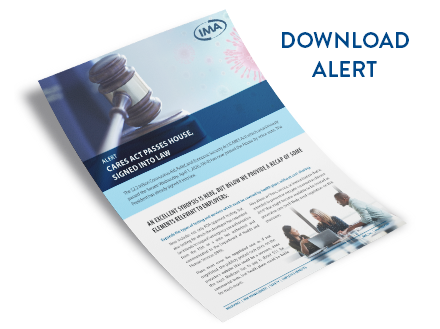COVID-19
CARES Act Passes House
Answers to a few of the most-discussed CARES Act questions during COVID-19.
Coronavirus has had an impact on the ability of businesses to perform. It is prudent for businesses to review the information that may have lasting results on their relationships impacted by this pandemic.
Alert: CARES Act Passes House, Signed Into Law
The $2.2 trillion Coronavirus Aid, Relief, and Economic Security Act (CARES Act) which unanimously passed the Senate, Wednesday, April 1, 2020 (96-0) has now passed the House by voice vote. The President has already signed it into law.
An excellent synopsis is here, but below we provide a recap of some elements relevant to employers:
Expands the types of testing and services which must be covered by health plans without cost sharing
- Now includes not only FDA-approved testing, but also testing for which the developer has requested (or intends to request) emergency use authorization from the FDA or a state has authorized and communicated to the Department of Health and Human Services (HHS)
- Plans must cover the negotiated cost or, if not negotiated, the publicly posted cash price on the provider’s website (this could be a concern, since the most Medicare has to pay is about $51 for commercial tests, but health plans could be liable for much more)
- Also allows an “item, service, or immunization that is intended to prevent or mitigate coronavirus disease 2019” that might become available to be treated as preventive care (we’ll likely need regulation on this provision)
Changes to the Families First Coronavirus Response Act (FFCRA)
A new rule under the Emergency Family and Medical Leave Expansion Act (EFML) that would immediately cover rehired employees the day of rehire if they were laid off March 1, 2020 or later and worked at least 30 of the last 60 days before layoff
Allows for advances on anticipated tax credits (rules to follow) and penalty relief for failure to deposit tax amounts in anticipation of credits allowed
Clarifies all aggregate dollar limits in both paid leave provisions are “per employee” (this clarity was missing from the FFCRA)
Postpones employer payroll tax deposit due dates
Provides eligible employers (including for-profit and tax-exempt organizations but not governmental entities) an employee retention credit that is refundable
For plan years on or before December 31, 2021, all telemedicine services are allowable at low or no cost sharing prior to the deductible without jeopardizing health savings account (HSA) eligibility (so HSA-qualified plans renewing on/after January 1, 2022 will need to remember to reset their telemedicine benefits back to charging a fair market value for telemedicine)
Permanently repeals (retro to January 1, 2020) the Affordable Care Act (ACA) rule that required a prescription to reimburse non-insulin over-the-counter medicines…this will now allow HSAs and health flexible spending accounts (FSAs) to reimburse OTC without a prescription, and the list of qualified OTC is expanded to include menstrual products
Federal funding for unemployment compensation (UC) to certain gig-economy workers, waiver of the one-week waiting period, an additional $600 per week for up to four months (even if that takes the employee above prior earnings), an additional 13 weeks of UC, and UC for reduced hours in participating states.
Recovery rebates to American taxpayers of $1,200 ($2,400 for joint filers) plus $500 per child, phased out at $75,000 income ($112,500 for heads of household, $150,000 for joint filers)
Several retirement plan flexibilities (early hardship distributions, loan maximums, minimum funding contributions delay, etc.)
For charitable contributions, increases the 10% limitation on corporations to 25%, the 15% limitation on food inventory to 25%, and includes changes for individuals
Expands the definition of employer-provided educational assistance that is excluded from gross income to include up to $5,250 in student loan payments made by an employer between enactment and December 31, 2020
$150 billion to the states to respond to COVID-19, $100 billion to HHS to reimburse health care providers for COVID-19 related costs and revenue losses, and many other government funding programs
Several loan programs, some with deferment options and even potential loan forgiveness
This material is for general information only and should not be considered as a substitute for legal, medical, tax and/or actuarial advice. Contact the appropriate professional counsel for such matters. These materials are not exhaustive and are subject to possible changes in applicable laws, rules, and regulations and their interpretations.
